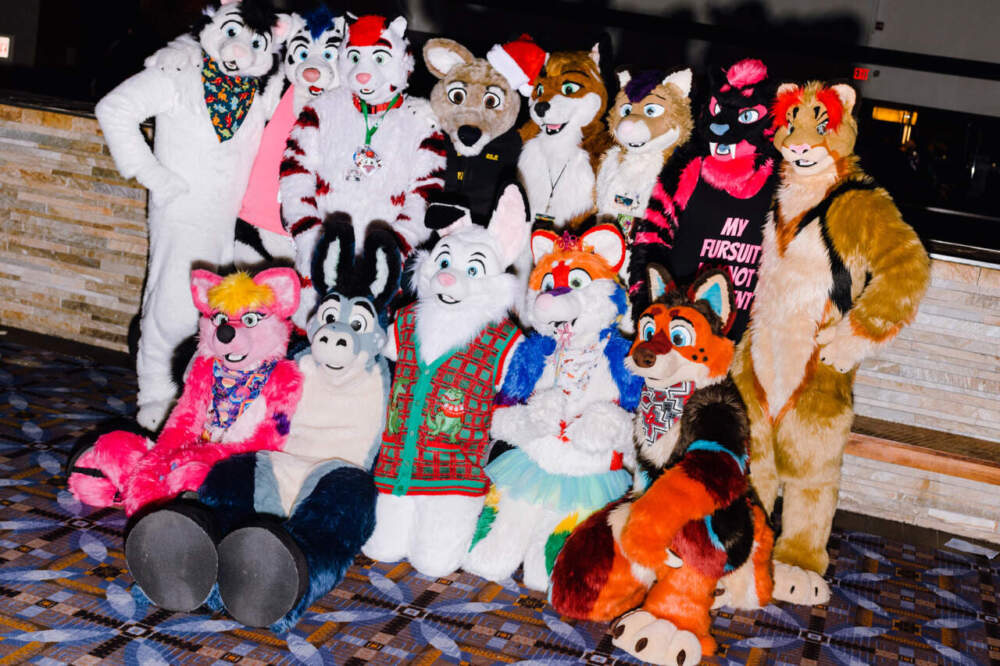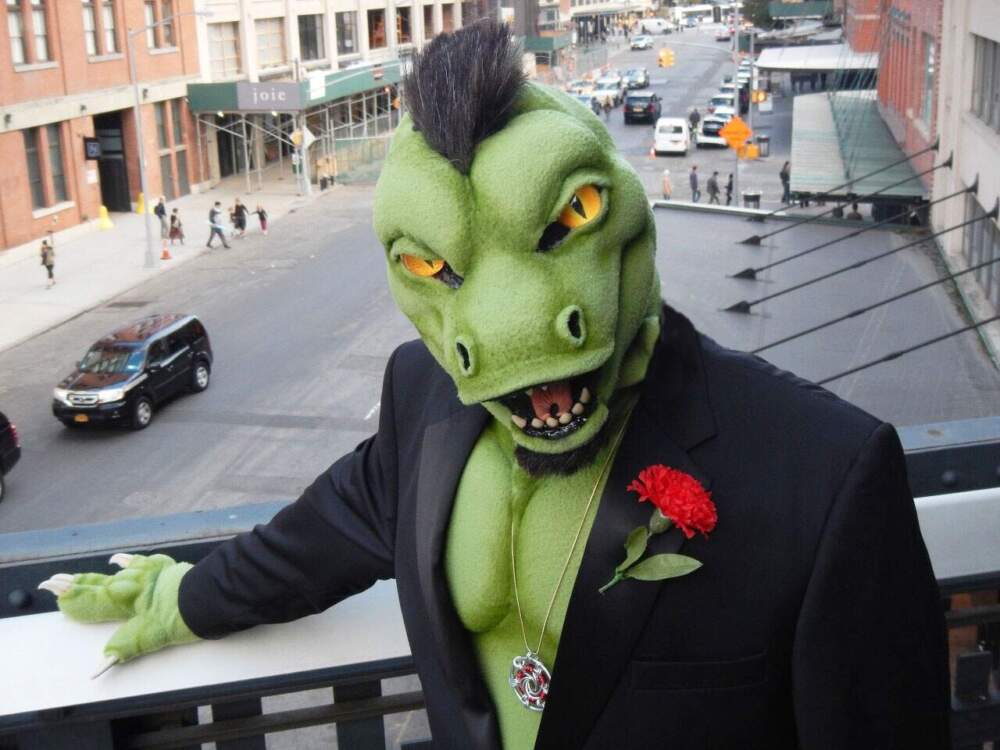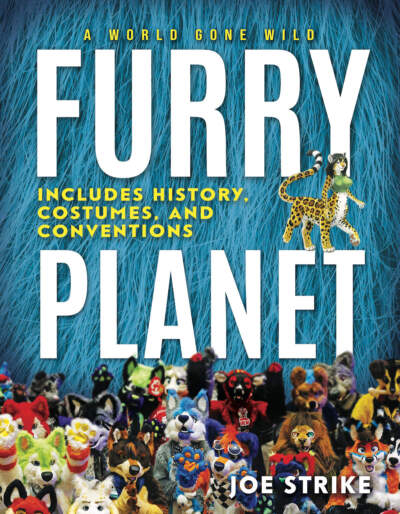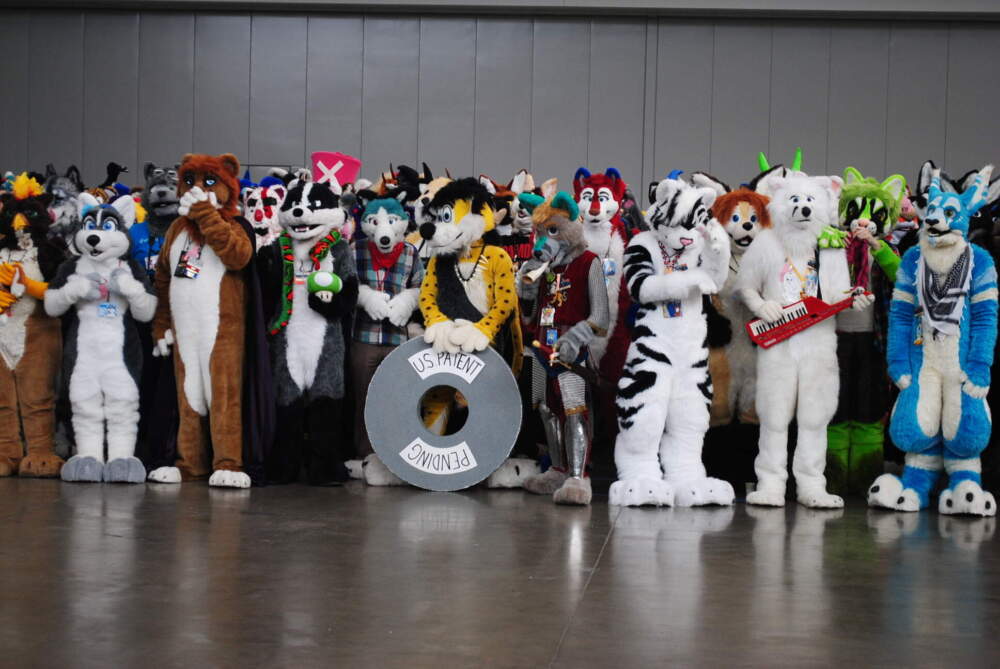Advertisement
With perky ears and tails wagging, 'furries' converge in Boston

Take a stroll through Boston’s Seaport this weekend and you might encounter colorful packs of bipedal animals. We’re talking lions and tigers and cheetahs, oh my! That’s because Anthro New England at the Westin Boston Seaport Hotel is welcoming thousands of costumed fans for a three-day celebration of furry culture.
What’s furry culture, you ask?
Well, if you feel most like yourself in bunny slippers, have a stuffed animal on the dashboard of your car, connect spiritually to cartoon characters like Disney’s foxy Robin Hood, Winnie-the-Pooh, or video game icon Sonic the Hedgehog, you could be — shall we say — furry-inclined. But avid devotees, known as furries, take their affections further by donning ears, tails or full-body “fursuits.” Some adopt "fursonas."
To find out more about this community and its fascination with anthropomorphic animals in art, cartoons, comics and literature, we reached out to author and longtime fur Joe Strike. He’ll be attending Anthro New England and brings us into the fold of furry fandom, which he says goes beyond fetish.
Interview Highlights
Andrea Shea: I love how you joke about the “f” word in your 2023 book, “Furry Planet.” For those who are not familiar with this growing subculture, what exactly is a furry?
Joe Strike: My personal definition of a furry is someone who has an above-average interest in anthropomorphic animal characters. Humans taking on animal guises for tribal or cultural reasons have been part of the human imagination since the beginning of civilization. Most of this has been forgotten in modern times, except in our enjoyment of cartoon animals as well as advertising and sports mascots. But furs are people who feel this instinct on a personal, visceral level — it’s an ancient, atavistic instinct we’ve rediscovered and take seriously. We invent animal personalities, alter egos, for ourselves we call “fursonas.” (When I’m not myself, I’m a sinister yet alluring Komodo dragon named Komos.)

Shea: People connect to all manner of anthropomorphic animals — from mainstream cartoon characters like Mickey Mouse, to comic book icons including the Teenage Mutant Ninja Turtles, and literary creatures from books like “Watership Down,” “Paddington,” and “Stewart Little.” Oh, and there’s Kimba the White Lion of manga fame. Who are some other examples?
Strike: I’d add Bugs Bunny and the Looney Tunes characters, Peter Rabbit, Smaug, the “Lord of the Rings” dragon, the “My Little Pony” equines, and the imaginary Pokémon animals that are very popular with younger furs. As a baby boomer, I can go back to my college days when Herman Hesse’s “Steppenwolf” — about a man who sees himself torn between his human identity and the feral wolf he feels he truly is — was a popular read. There are hundreds of other examples I’m sure other furs can add to the list.
Shea: The furry community is connected to the science fiction, comic book, anime and cosplay worlds. In your books, you trace it back to the 1980s when like-minded people found each other at sci fi conventions and started organizing “furry parties.” How has the landscape evolved for furries?
Strike: Furry has its roots in those areas but has evolved totally into its own thing. Now there are innumerable, specifically-furry conventions like Anthro New England. Major ones like Pittsburgh’s Anthrocon and Chicago’s Midwest FurFest are enormous. These attendance figures keep rising year after year as more people discover furry and/or connect with their own anthropomorphic instincts.
Shea: Your first book is titled, “Furry Nation: The True Story of American’s Most Misunderstood Subculture.” How and why has it been misunderstood?
Strike: I think the basic misunderstanding comes from an assumption that pretending to be or “dressing up” as animals is something only children should indulge in. If adults do it, it’s simply “wrong,” and people imagine spurious connections to bestiality, pedophilia, or just feel a general discomfort with the idea for no particular reason.

Shea: Your latest book, “Furry Planet: A World Gone Wild,” illuminates how fur culture has gone global. One of the furries you spoke with in China said dressing up in costume allows him to release the childlike part of himself that we often suppress as adults with jobs and responsibilities. What are some other reasons why people wear ears, tails and full-blown animal costumes?—
Strike: It’s definitely a fun escape from one’s everyday life and personality! It really isn’t different from someone becoming Batman or Luke Skywalker or Harry Potter at a sci-fi convention. There is one major difference between furs and fans of those mainstream genres: (a lot of) furs invent and become their own, original anthropomorphic characters. As far as I know, there isn’t an existing Komodo dragon anywhere in pop culture — but when I become Komos, I can be sinister, domineering, and make-believe “evil” (which a lot of people find quite intriguing and attractive) — which is so not me! For some furs, their “fursona” is who they feel is their true self, the essence of who they are. Most furs don’t get as deeply into it of course; for them, wearing ears or tails at a furry convention is just a way of identifying themselves as part of the community without necessarily creating an alternate personality for themselves.

Shea: You’re a champion for this community — do you feel like you have to defend furry culture’s relevance?
Strike: Yes, I do, to the best of my ability, put on the record who we truly are and why we do what we do. I also feel it’s important to explore that deeper connection between the human and non-human animal worlds; anything relating to anthropomorphic animals is an attempt to bridge that gap.
Many people think, “I’m so weird for being into this stuff, I can’t talk about it with anyone…” and then they discover, no, there are tens of thousands of people who feel exactly the same way you do!
Shea: You wrote about the community being a safe space for people who feel like outsiders, including queer youth. How does the community foster a sense of belonging?
Strike: Again, it’s that “I’m not the only one!” feeling — realizing, “these people understand and accept me for who and what I am — I don’t have to hide my secret self any longer.” Whether it’s being gay, bi, queer, non-binary, etc. — or being a dragon. There’s also so much mutual support with/from people who know how you feel, because they’ve felt that way themselves.

Shea: There is an erotic angle to furry culture. In your book you acknowledge, “Yes, there is furry porn.” But there’s also fur-friendly media — including furry community news websites like "Dogpatch Press" and "Global Furry Television" in Singapore. It seems award-winning British comedian and "Last Week Tonight" host John Oliver has an affection! What does that say to you about how far furry culture has come?
Strike: John Oliver has all but flat out stated he’s a furry. (“The clues are all there,” as he said on his show.) I’d rather not mention his name, but I’ll just call him “X” (as he renamed Twitter), is aware of furry and even called himself “fur-curious.” I’m also seeing more references to furry as just a thing in the culture at large, and not something scandalous, juvenile, or perverse. Stephen Colbert outright brags about being a total Lord of the Rings nerd, and someday I’d like to hear John Oliver come out of the furry closet about his otter fursona.
Shea: What are you most looking forward to this weekend?
Strike: Komos unfortunately is in the repair shop at the moment to mend a serious tail burn, but I may bring and wear his head at the convention. Most of all though, I’m hoping to spend time with furfriends I otherwise only meet online.
